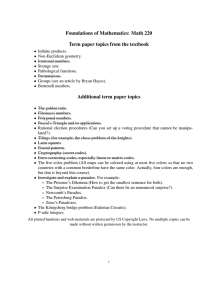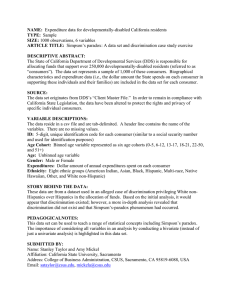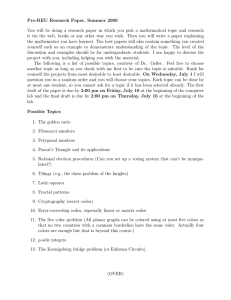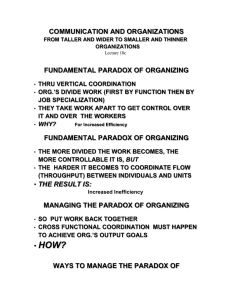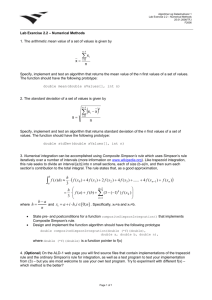On Simpson’s Paradox for Discrete Lifetime Distributions Daniel Lebowitz June 10, 2013
advertisement
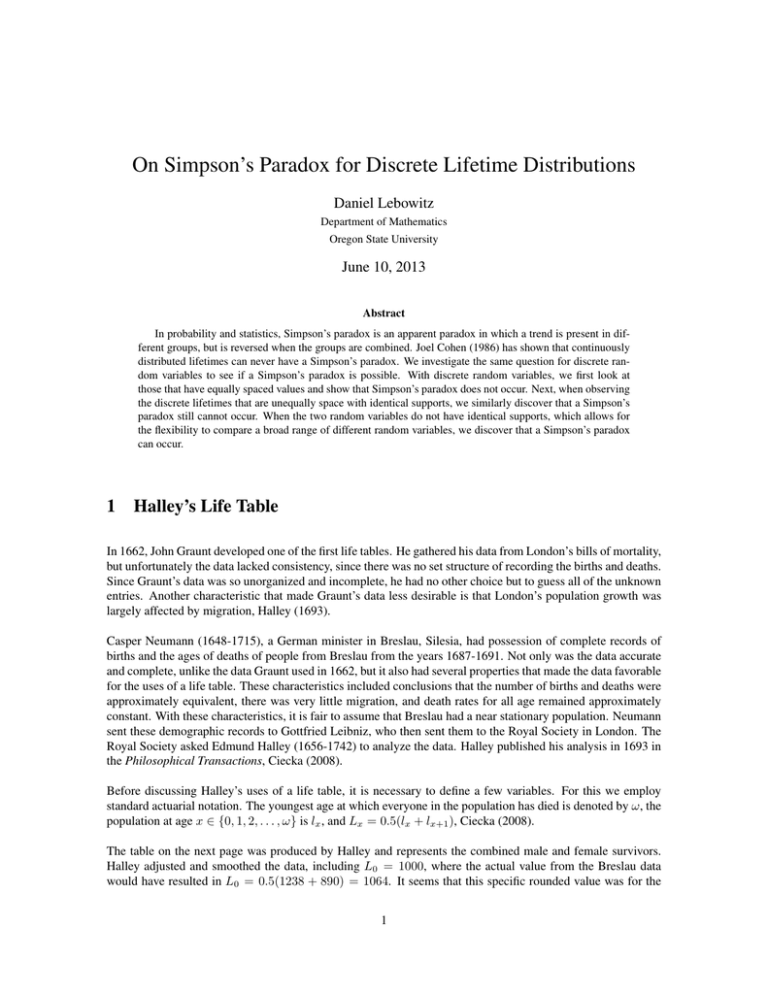
On Simpson’s Paradox for Discrete Lifetime Distributions
Daniel Lebowitz
Department of Mathematics
Oregon State University
June 10, 2013
Abstract
In probability and statistics, Simpson’s paradox is an apparent paradox in which a trend is present in different groups, but is reversed when the groups are combined. Joel Cohen (1986) has shown that continuously
distributed lifetimes can never have a Simpson’s paradox. We investigate the same question for discrete random variables to see if a Simpson’s paradox is possible. With discrete random variables, we first look at
those that have equally spaced values and show that Simpson’s paradox does not occur. Next, when observing
the discrete lifetimes that are unequally space with identical supports, we similarly discover that a Simpson’s
paradox still cannot occur. When the two random variables do not have identical supports, which allows for
the flexibility to compare a broad range of different random variables, we discover that a Simpson’s paradox
can occur.
1
Halley’s Life Table
In 1662, John Graunt developed one of the first life tables. He gathered his data from London’s bills of mortality,
but unfortunately the data lacked consistency, since there was no set structure of recording the births and deaths.
Since Graunt’s data was so unorganized and incomplete, he had no other choice but to guess all of the unknown
entries. Another characteristic that made Graunt’s data less desirable is that London’s population growth was
largely affected by migration, Halley (1693).
Casper Neumann (1648-1715), a German minister in Breslau, Silesia, had possession of complete records of
births and the ages of deaths of people from Breslau from the years 1687-1691. Not only was the data accurate
and complete, unlike the data Graunt used in 1662, but it also had several properties that made the data favorable
for the uses of a life table. These characteristics included conclusions that the number of births and deaths were
approximately equivalent, there was very little migration, and death rates for all age remained approximately
constant. With these characteristics, it is fair to assume that Breslau had a near stationary population. Neumann
sent these demographic records to Gottfried Leibniz, who then sent them to the Royal Society in London. The
Royal Society asked Edmund Halley (1656-1742) to analyze the data. Halley published his analysis in 1693 in
the Philosophical Transactions, Ciecka (2008).
Before discussing Halley’s uses of a life table, it is necessary to define a few variables. For this we employ
standard actuarial notation. The youngest age at which everyone in the population has died is denoted by ω, the
population at age x ∈ {0, 1, 2, . . . , ω} is lx , and Lx = 0.5(lx + lx+1 ), Ciecka (2008).
The table on the next page was produced by Halley and represents the combined male and female survivors.
Halley adjusted and smoothed the data, including L0 = 1000, where the actual value from the Breslau data
would have resulted in L0 = 0.5(1238 + 890) = 1064. It seems that this specific rounded value was for the
1
convenience of having a radix of 1000, Ciecka (2008).
Age x
1
2
3
4
5
6
7
8
9
10
11
12
13
14
15
16
17
18
19
20
21
22
Lx−1
1000
855
798
760
732
710
692
680
670
661
653
646
640
634
628
622
616
610
604
598
592
586
Age x
23
24
25
26
27
28
29
30
31
32
33
34
35
36
37
38
39
40
41
42
43
44
Lx−1
579
573
567
560
553
546
539
531
523
515
507
499
490
481
472
463
454
445
436
427
417
407
Age x
45
46
47
48
49
50
51
52
53
54
55
56
57
58
59
60
61
62
63
64
65
66
Lx−1
397
387
377
367
357
346
335
324
313
302
292
282
272
262
252
242
232
222
212
202
192
182
Age x
67
68
69
70
71
72
73
74
75
76
77
78
79
80
81
82
83
84
Lx−1
172
162
152
142
131
120
109
98
88
78
68
58
49
41
34
28
23
20
85-100
107
Total
34000
The following observations, and their explanations, were obtained by Halley and published in his classic papers,
Ciecka (2008).
1. ”Proportion of men able to bear arms” (ages 18 to 56).
Assuming that half of the population consists of men, Halley derived
L17 + L18 + · · · + L55
= 0.265
2 ∗ 34000
where the population of Breslau was 34,000.
2. The odds of survival between two ages.
This compares the number of deaths to the number that survived between two ages
Lx+t
Lx − Lx+t
Ex: The odds of surviving through the teenage years is
L19
598
=
= 598 : 42 = 14.2 : 1
L12 − L19
640 − 598
3. The age where it is an ”even wager” that a person at a current age would survive or die.
2
Ex: If we were to look at a 52 year old and wanted to determine the age of survival needed to have an even
wager, then we would observe that L51 = 324 and L67 = 162 = L51 /2. Therefore, an even wager for a 52
year old would be living an additional 16 years or reaching the age of 68.
4. To regulate the price of term insurance.
The price is determined by the odds of survival, which Halley observed the odds of survival of 1 year.
5. Life annuity
Halley used the following formula for a life annuity:
ax =
ω−x−1
X
(1 + i)−t
t=1
Lx+t−1
Lx−1
This calculation determines the expected present value of a life annuity of one pound at a given present age and
a fixed discount rate (Halley used 6%).
Ex: The expected present value of a life annuity of one pound for a 70 year old, based on a fixed discount rate
of 6%, would be (using Halley’s life table)
a70 =
15
X
(1.06)−t
t=1
L79+t
= 5.32
L79
6. Joint life annuity of two lives.
Suppose that Lx represents lives at age x and Ly represents lives at age y. Furthermore, consider t Dx and
t Dy , which represents the number of deaths from Lx and Ly within t years, respectively. Therefore, Lx =
Lx+t +t Dx and Ly = Ly+t +t Dy . Halley was able to derive the probability of at least one life surviving as
1−
(t Dx )(t Dy )
(Lx+t )(Ly+t ) + (Lx+t )(t Dy ) + (Ly+t )(t Dy )
=
Lx Ly
Lx Ly
Therefore, the expected present value of the life annuity that pays when at least one of the two individuals
survives would be
ω−x−1
X
(t Dx )(t Dy )
−t
axy =
(1 + i)
1−
Lx Ly
t=1
7. Joint life annuity on three lives.
Similarly to the joint life annuity on two lives, consider three lives at ages x, y, and z. Halley concluded that
the value of a life annuity that pays when at least one of the three individuals is alive would be
ω−x−1
X
(t Dx )(t Dy )(t Dz )
−t
axyz =
(1 + i)
1−
Lx Ly Lz
t=1
Also, consider an annuity that pays the youngest of the three individuals only after the older two die. Let
x = min{x, y, z}. Halley determined that the value of this annuity is
ω−x−1
X
(Lx+t )(t Dy )(t Dz )
ayz|x =
(1 + i)−t
Lx Ly Lz
t=1
3
There are a couple notable observations about Halley’s work. First, life tables similar to Halley’s are still being
used this present day. Secondly, a major difference between Halley’s calculations and the calculations used
today is that Halley uses average survivors (Lx ) rather than exact survivors (lx ), although some interpret Halley
as using the exact survivors in his calculations. Regardless, it was fair to say that Edmond Halley was a pioneer
in the development of survival analysis, Ciecka (2008). He is often referred to as the ’Father of Actuarial Science’, Waymire (1988) and references therein.
2
Stochastic, Hazard Rate, and Relative Log-Concavity Orders
In this section we will look at some important concepts that are used throughout survival analysis. The definitions that will be introduced are going to be utilized throughout the remaining sections.
Definition 1. Let L be a positive random variable representing the age at death of an individual. The survival
function of L is defined as
SL (t) = P (L > t) = 1 − FL (t)
Notice the density function, fL (t), when it exists is the negative derivative of the survival function.
Definition 2. Let L be the age of death of a random individual being a continuous distribution with density
fL (t). Then the hazard rate of L is defined as
P (t < L ≤ t + ∆|L > t)
fL (t)
−SL0 (t)
=
=
∆→0
∆
1 − FL (t)
SL (t)
λL (t) = lim
The following are standard forms of hazard rates in actuarial science
(a) λ(t) = Bct , where B, c > 0 and 0 ≤ t < ∞;
(b) λ(t) = A/(B − t)c+1 , where A, B, c > 0 and t ≤ B;
(c) λ(t) = H(t − B)c−1 , where c, H > 0 and t ≥ B.
Brillinger (1961) provides a theoretical basis using extreme value theory. Form (a) is known as Gompertz’s Law,
which shows the hazard rate increases geometrically over time, which is a sufficient model limited for specific
time periods of an individual’s life. Forms (b) and (c) are mentioned by Brillinger (1961) as being Makeham’s
First and Second Law, respectively. Although, others (H. L. Rietz) express Makeham’s First and Second Law
differently. Rietz (1986) expresses Makeham’s First Law as λ(t) = A + Bct , which is identical to Gompertz’s
Law, but contains a term independent of t. Then with Makeham’s Second Law, Rietz (1986) expresses it as
λ(t) = A + Dt + Bct , which is identical to Makeham’s First Law, but with a linear term.
Notice, one may either (a) fit continuous hazard rates to data, or (b) address the data explicitly with discrete hazard rates. Consider the lifetime of a random individual to be discretely measured, which aligns more closely to
the data gathered in Halley’s life table. This means the time periods until the death of any individual is discrete
instead of continuous. If a lifetime is discretely measured, then with comparison to the definition above, notice
∆ ∈ N, which is the distance between two consecutive values that this lifetime may obtain. Furthermore, if ni
4
is the ith possible lifetime of an individual, then ∆ = ni − ni−1 and notice
P (ni−1 < L ≤ ni−1 + ∆|L > ni−1 )
P (ni−1 < L ≤ ni |L > ni−1 )
=
∆
ni − ni−1
=
=
P (L = ni |L ≥ ni )
ni − ni−1
P (L = ni )
(ni − ni−1 )P (L ≥ ni )
Grimshaw et al. (2005) defines the hazard rate of a discrete random variable, where ni − ni−1 = 1 for all i,
and we will be considering ni − ni−1 ∈ N. However, we wish to also include the case of unequal spacing as
follows.
Definition 3. Let L be a positive random variable with possible values {n1 , n2 , . . . }. Then the hazard rate of
L is defined as
P (L = ni |L ≥ ni )
λL (ni ) =
ni − ni−1
where ni−1 , ni ∈ N, ni−1 < ni for all i, and n0 = 0.
We will define hazard rate order, which will be used throughout sections 3, 4, and 5. Stochastic order will also
be defined and we will see that these two orders will share relations when distributions have specific conditions.
Definition 4. Let LA and LB be continuous random variables on R+ with density functions, or discrete random
variables on N with mass functions, fLA (t) and fLB (t), respectively. Also, denote their respective cumulative
distribution functions by FLA (t) and FLB (t).
• LA is said to be smaller than LB in the stochastic order, or LA ≤st LB , if SLA (t) ≤ SLB (t) for all t.
• LA is said to be smaller than LB in the hazard rate order, or LA ≤hr LB , if fLA (t)/SLA (t) ≥
fLB (t)/SLB (t) for all t.
It can be shown that ≤hr implies ≤st for both discrete and continuous random variables. The discrete case can
proven using Proposition 2 in Section 4.
Definition 5. Let L be a continuous random variable on R+ with density function, or discrete random variables
on N with mass function, fL (t). Then the support of L is defined as
supp(L) = {t : fL (t) > 0}
The inequality used to define log-concave in Definition 6 (below) is well known as Newton’s inequality. The
definition of log-concave is addressed by Yu (2010). Log-concavity order provides the ability to derive conditions that imply both stochastic ordering and hazard rate ordering as illustrated in Example 2.
Definition 6. A non-negative sequence u = {uj , j ≥ 1} is log-concave, or equivalently, log (uj ) is concave in
supp(u) if
5
• the supp(u) is a set of consecutive integers in N; and
• u2j ≥ uj+1 uj−1 for all j.
Definition 7. Let LA and LB be continuous random variables on R+ with density functions, or discrete random
variables on N with mass functions, fLA (t) and fLB (t), respectively. We say LA is log-concave relative to LB ,
denoted LA ≤lc LB , if
• supp(LA ) and supp(LB ) are both intervals in R+ if LA and LB are continuous random variables or
consecutive integers in N if LA and LB are discrete random variables;
• supp(LA ) ⊂ supp(LB );
• log(fLA (t)/fLB (t)) is a concave function on supp(LA ).
Although all three orderings can be applied to both discrete and continuous random variables, the main purpose
of this paper is to analyze the characteristics of discrete lifetimes, so we will emphasize the discrete portion of
the definitions. Information on the continuous properties involved and more details of discrete random variables
can found in Yu (2009).
Theorem 1 (Yu). Let random variables LA and LB have mass functions fLA (t) and fLB (t) respectively, both
supported on the same N or {1, 2, . . . , n} for some n ∈ N . Assume LA ≤lc LB . Then LA ≤st LB and
LA ≤hr LB are equivalent, and each holds if and only if fLA (1)/fLB (1) ≥ 1.
Example 1. Suppose LA ∼ Geom(pa ) and LB ∼ Geom(pb ). First there is a need to check when LA ≤lc LB .
Notice supp(LA ) = supp(LB ) = N. By the definition of log-concave
(1 − pa )n−1 pa
(1 − pb )n−1 pb
2
≥
(1 − pa )n pa
(1 − pb )n pb
(1 − pa )n−2 pa
(1 − pb )n−2 pb
for all n ∈ N, which simplifies to 1 ≥ 1, so there are no restrictions to the values of pa and pb based on
log-concavity. Consider, LA ≤st LB . Notice, for all n ∈ N
(1 − pa )n−1 = P (first n − 1 are failures) = P (LA ≥ n) ≤ P (LB ≥ n) = (1 − pb )n−1
Therefore pa ≥ pb . Notice, for all n ∈ N
λLA (n) =
P (LA = n)
(1 − pa )n−1 pa
=
= pa
P (LA ≥ n)
(1 − pa )n−1
Since pa ≥ pb , then LA ≤hr LB and it is easy to see that P (LA = 1)/P (LB = 1) ≥ 1. Therefore, we can see
that Theorem 1 is true with geometric random variables.
In the next example, Theorem 1 plays a more essential role in verifying hazard rate ordering.
Example 2. Suppose LA ∼ P ois(θa ) and LB ∼ P ois(θb ), where θa and θb are positive. First there is a need
to check when LA ≤lc LB . Notice supp(LA ) = supp(LB ) = N. By the definition of log-concave
θan−1 e−θa
θbn−1 e−θb
2
≥
θan e−θa
θbn e−θb
6
θan−2 e−θa
θbn−2 e−θb
for all n ∈ N, which simplifies to 1 ≥ 1, so there are no restrictions to the values of θa and θb based on logconcavity, similarly to Example 1. Notice, if we consider P (LA = 1)/P (LB = 1) ≥ 1, which is equivalent to
e−θa ≥ e−θb , then θa ≤ θb , since θa and θb are both positive.
In order to show that LA ≤st LB we need for all n ∈ N
n
X
θk−1 e−θa
a
(k − 1)!
k=1
≥
n
X
θk−1 e−θb
b
(k − 1)!
k=1
Since θa ≤ θb , then take θb = θa + γ, where γ ≥ 0. Therefore, the above inequality is equivalent to showing
for all γ ≥ 0
n
n
X
θak−1 e−θa X (θa + γ)k−1 e−(θa +γ)
g(γ) =
−
(k − 1)!
(k − 1)!
k=1
k=1
!
n
n
X
X
θak−1
(θa + γ)k−1 e−γ
−θa
=e
−
≥0
(k − 1)!
(k − 1)!
k=1
k=1
0
Notice, g(0) = 0, so if we show that g (γ) ≥ 0 for all γ ≥ 0, then g(γ) ≥ 0 for all γ ≥ 0. Therefore for all
n∈N
!
n
n
X
e−γ (θa + γ)k−1 X e−γ (k − 1)(θa + γ)k−2
0
−θa
−
g (γ) = e
(k − 1)!
(k − 1)!
k=2
k=1
!
n
n−1
X
e−γ (θa + γ)k−1 X e−γ (θa + γ)k−1
−θa
=e
−
(k − 1)!
(k − 1)!
k=1
k=1
= e−θa
e
−γ
= e−θb
(θa + γ)n−1
(n − 1)!
(θb )n−1
>0
(n − 1)!
Therefore, LA ≤st LB .
In order to show that LA ≤hr LB we need for all n ∈ N
1−
θan e−θa
Pn−1 θak−1 e−θa ≥
k=1
(k−1)!
1−
θbn e−θb
Pn−1 θbk−1 e−θb
k=1
(k−1)!
To show this is true was nontrivial. Fortunately, since we have shown that when assuming LA ≤lc LB and
P (LA = 1)/P (LB = 1) ≥ 1, then the conditions result in LA ≤st LB . Therefore, by applying Theorem 1, we
know that LA ≤hr LB .
3
Absence of Simpson’s Paradox for Continuous Lifetime Distributions
In probability and statistics, Simpson’s paradox is an apparent paradox in which a trend is present in different
groups, but is reversed when the groups are combined. The following are well-known illustrations of Simpson’s
paradox.
7
Example 3. An instance where the Simpson’s paradox may occur is with baseball players’ batting averages.
Consider the batting averages of two consecutive years of two fictional baseball players. Suppose that Mark was
up to bat 100 times in 2011 and 2012 combined, during which he makes 28 hits for a proportion of 0.280. On
the other hand, Sam was also up to bat 100 times in 2011 and 2012 combined, but had 29 hits for a proportion
of 0.290. Notice in the table below, that Mark had a higher batting average than Sam when comparing each year
individually.
2011
2012
Total
Mark
0.340 (17/50)
0.220 (11/50)
0.280 (28/100)
Sam
0.320 (24/75)
0.200 (5/25)
0.290 (29/100)
Example 4. A real life example of an occurrence of Simpson’s paradox was in a medical study involving the
success rate of two kidney stone treatments. Treatment A includes all open procedures and treatment B was a
process called percutaneous nephrolithomy. It was determined that treatment B was more successful then treatment A. When considering the variable of the size of the stone for each patient it was determined that treatment
A was more successful for both small and large sized stones. The resulting data from the study can be seen in
the table below.
Small Stones
Large Stones
Total
Treatment A
93% (81/87)
73% (192/263)
78% (273/350)
Treatment B
87% (234/270)
69% (55/80)
83% (289/350)
In order to quantify Simpson’s paradox in the context of actuarial lifetime data, Joel Cohen (1986) made the
following observations.
Definition 8. Let L be the age of death of a random individual, which is non-negative. The crude death rate of
L is defined as
1
dL =
E[L]
The following well-known relation between the hazard rate and survival probability will be used for the continuous case.
Theorem 2. Let L be the age of death of a random individual, which is non-negative. Then
Z t
SL (t) = exp −
λL (s)ds
0
Proof. Suppose L is the age of death of a random individual, which is non-negative. Using Definition 2,
λL (t) =
fL (t)
1 − FL (t)
d
ln (1 − FL (t))
dt
d
= − ln SL (t)
dt
=−
8
Then apply the antiderivative and obtain
Z t
λL (s)ds
SL (t) = exp −
0
The following result is also well-known from probability theory.
Theorem 3. Let L be the age of death of a random individual being a continuous distribution with density
fL (t). Then
Z ∞
SL (t)dt
E[L] =
0
Proof. Since the lifetime of an individual is strictly positive, the expectation of a random variable L would be
obtained by multiplying t by the density fL (t) and integrating, so
Z ∞
tfL (t)dt
E[L] =
0
By integration by parts, recognizing that −fL (t) is the derivative of SL (t), SL (0) = 1, SL (∞) = 0, and
limt→∞ tSL (t) = 0 notice
Z ∞
E[L] =
tfL (t)dt
0
= (−tSL (t))|∞
0 −
Z
∞
−SL (t)dt
0
Z
=
∞
SL (t)dt
0
Robert Parke asked if Simpsons paradox could happen when comparing age-specific (hazard rate) and crude
death rates of two populations. This question was prompted due to the stratification of sex when determining
the rates for annuities, when other factors, such as being Mormon, an individual’s ethnicity, being a smoker,
etc..., have a greater impact on mortality, but were being ignored when determining an individual’s rates, Cohen
(1986).
In the context of continuously distributed actuarial life data Cohen (1986) formulated Simpson’s paradox as
follows:
Definition 9. Consider populations A and B with random individuals with lifetimes LA and LB , respectively.
Let λLA (t) ≥ λLB (t) for all t > 0. A Simpson’s paradox exists if dLA < dLB .
Theorem 4 (Cohen). Consider populations A and B with random individuals with continuously distributed
lifetimes LA and LB , respectively. If λLA (t) ≥ λLB (t), ∀t > 0, then dLA > dLB .
9
Proof. Suppose LA and LB are the age of death of a random individual from populations A and B, respectively,
such that λLA (t) > λLB (t), ∀t > 0. This implies that
Z
t
Z
λLA (s)ds >
t
λLB (s)ds
0
0
for all t > 0, then by Theorem 2
Z t
Z t
SLA (t) = exp −
λLA (s)ds < exp −
λLB (s)ds = SLB (t)
0
0
for all t > 0. Then by Theorem 3
Z
E[LA ] =
∞
Z
SLA (s)ds <
0
∞
SLB (s)ds = E[LB ]
0
and then by the definition of crude death rate
dLA =
1
1
>
= dLB
E[LA ]
E[LB ]
Therefore, a Simpson’s paradox could not happen when comparing age-specific and crude death rates of two
stationary populations.
Thus, one may conclude that if one uses the procedure of fitting a continuous hazard rate to data, then Simpson’s
paradox will not be an issue. However fitting a discrete hazard rate to data may introduce other issues.
4
Absence of Simpson’s Paradox for Equally Spaced Discrete Lifetime
Distributions and Identical Support
It has been established that Simpson’s paradox cannot occur for continuous lifetime distributions. This still
leaves the possibility of Simpson’s paradox occurring when lifetimes are discretely measured, since Cohen’s
proof depended on properties that are present strictly for continuous distributions. When considering lifetimes
that are discretely measured, each random variable considered will have support in N = {1, 2, . . . }. If a
random variable L0 has support in {0, 1, 2, . . . }, consider the transformed random variable L1 = L0 + 1,
which would have the desired support in N. Notice, if we have discrete random variables LA and LB , where
supp(LA ) = supp(LB ) (identical supports), it could be easily shown that λLA (n) ≥ λLB (n) for all n ∈ N is
equivalent to LA ≤hr LB . The following examples are presented as warm up to the general theorem.
Example 5. A Simpson’s paradox cannot occur when lifetimes are geometrically distributed.
Proof. Suppose that LA ∼ Geom(pa ), LB ∼ Geom(pb ), and LA ≤hr LB . From Example 1 we determined
that when LA ≤hr LB , then pa ≥ pb .
Therefore,
dLA =
1
1
1
1
=
= pa ≥ pb =
=
= dLB
E[LA ]
1/pa
1/pb
E[LB ]
10
Hence, there is no Simpson’s paradox when lifetimes are geometrically distributed.
Consider LA ∼ Geom(pa ) and LB ∼ Geom(pb ), where pa > pb . If interested in determining for what values
of n such that P (LA = n) > P (LB = n), notice
(1 − pa )n−1 pa > (1 − pb )n−1 pb
n−1
pb
1 − pa
>
1 − pb
pa
Since pa > pb , it is evident that for at least n = 1 the inequality will hold. But it is inevitable that there
exists m ∈ {2, 3, . . . } such that for all k ∈ {m, m + 1, . . . } the inequality will not hold since the left
side of the inequality is decaying exponentially. Therefore, if the inequality does not hold, then for all k
P (LA = k) < P (LB = k) (possibly at k = m there may be equality). View the graph below, which exhibits
the case for when pa = 0.5 and pb = 0.25.
Geom(p=0.5)
Geom(p=0.25)
0.6
0.5
0.4
0.3
0.2
0.1
0
1
2
3
4
5
6
Example 6. A Simpson’s paradox cannot occur when lifetimes have a Poisson distribution.
Proof. Suppose that LA ∼ P ois(θa ), LB ∼ P ois(θb ), and LA ≤hr LB . From Example 2 we determined that
when LA ≤hr LB , then θa ≤ θb . So,
1
1
1
1
=
≥
=
= dLB
E[LA ]
θa + 1
θb + 1
E[LB ]
Hence, no Simpson’s paradox can occur when lifetimes have a Poisson distribution.
dLA =
11
Example 7. A Simpson’s paradox cannot occur when lifetimes have a Bernoulli distribution.
Proof. Suppose that LA is a Bernoulli random variable such that P (LA = 1) = pa and P (LA = 2) = 1 − pa ,
and LB is a Bernoulli random variable such that P (LB = 1) = pb and P (LB = 2) = 1 − pb . Also, suppose
LA ≤hr LB . Notice
pa =
P (LB = 1)
P (LA = 1)
= λLA (1) ≥ λLB (1) =
= pb
P (LA ≥ 1)
P (LB ≥ 1)
Also,
E[LA ] = pa + 2(1 − pa ) = 2 − pa
E[LB ] = 2 − pb
dL A =
1
1
1
1
=
≥
=
= dLB
E[LA ]
2 − pa
2 − pb
E[LB ]
Hence, no Simpson’s paradox can occur when lifetimes have a Bernoulli distribution.
Example 8. A Simpson’s paradox cannot occur when lifetimes have support {1, 2, 3}.
Proof. Suppose there are random variables LA and LB such that P (LA = j) = aj , P (LB = j) = bj , for
j ∈ {1, 2, 3}, where a1 + a2 + a3 = b1 + b2 + b3 = 1. Furthermore, consider LA ≤hr LB . For purposes of contradiction suppose there can be a Simpson’s paradox. So dLA < dLB , which is equivalent to E[LA ] > E[LB ].
Since LA ≤hr LB , then
a1 ≥ b1
(1)
a2 b3 ≥ a3 b2
(2)
Since E[LA ] > E[LB ], then a1 + 2a2 + 3a3 > b1 + 2b2 + 3b3 . Therefore
a1 + 2(1 − a1 − a3 ) + 3a3
=⇒ −a1 + a3 > −b1 + b3
From (1) we then obtain a3 > b3 .
Then, by (2) we know that a2 > b2 , but we know that this would lead to a contradiction since a1 + a2 + a3 =
b1 + b2 + b3 . Therefore, there is no Simpson’s paradox when lifetimes have support {1, 2, 3}.
Proposition 1. A Simpson’s paradox cannot occur when lifetimes have support {1, 2, . . . , n}.
Proof. Suppose there are random
Pn variablesPLnA and LB such that P (LA = j) = aj and P (LB = j) = bj ,
for j ∈ {1, 2, . . . , n}, where i=1 ai =
i=1 bi = 1. Furthermore, consider LA ≤hr LB . For purposes
of contradiction suppose there can be a Simpson’s paradox. So dLA < dLB , which is equivalent to E[LA ] >
E[LB ]. Notice for k ∈ {2, . . . , n − 1}
ak
bk
= P (LA = k|LA ≥ k) = λLA (k) ≥ λLB (k) = P (LB = k|LB ≥ k) =
ak + · · · + an
bk + · · · + bn
12
⇐⇒ ak (bk + · · · + bn ) ≥ bk (ak + · · · + an )
⇐⇒ ak bk + ak (bk+1 + · · · + bn ) ≥ ak bk + bk (ak+1 + · · · + an )
⇐⇒ ak (bk+1 + · · · + bn ) ≥ bk (ak+1 + · · · + an )
Therefore,
a1 ≥ b1
(3)
a2 (b3 + ... + bn ) ≥ b2 (a3 + ... + an )
(4)
a3 (b4 + ... + bn ) ≥ b3 (a4 + ... + an )
(5)
..
.
an−2 (bn−1 + bn ) ≥ bn−2 (an−1 + an )
(6)
an−1 bn ≥ bn−1 an
(7)
n
X
iai >
i=1
n
X
ibi
ai > 0, bi > 0, ∀i ∈ {1, . . . , n}
n
X
(8)
i=1
ai = 1 =
n
X
bi
(9)
(10)
i=1
i=1
Notice, either an ≥ bn or an < bn .
Case 1: Suppose an ≥ bn . Then by (7), an−1 ≥ bn−1 . Since an ≥ bn and an−1 ≥ bn−1 , then by (6),
an−2 ≥ bn−2 . Continuing this process we see that ai ≥ bi , ∀i ∈ {1, . . . , n}. By (10), we then obtain
ai = bi , ∀i ∈ {1, . . . , n}. But, this is a contradiction by (8).
Case 2: Suppose an < bn . Notice, either an−1 + an ≥ bn−1 + bn or an−1 + an < bn−1 + bn .
Subcase 1: Suppose an−1 + an ≥ bn−1 + bn . By an < bn , we have an−1 > bn−1 . Also by (6), an−2 ≥ bn−2 .
Similarly to the process from Case 1, we see that ai ≥ bi , ∀i ∈ {1, . . . , n − 2}. Also, since an−1 + an ≥
bn−1 + bn , then by (10) we obtain ai = bi , ∀i ∈ {1, . . . , n}. But, this is a contradiction by (8).
Subcase 2: Suppose an−1 + an < bn−1 + bn . Notice, an−2 + an−1 + an ≥ bn−2 + bn−1 + bn or an−2 +
an−1 + an < bn−2 + bn−1 + bn .
Subsubcase 3: Suppose an−2 + an−1 + an ≥ bn−2 + bn−1 + bn . Similarly to Subcase 1, we can show that
ai ≥ bi , ∀i ∈ {1, . . . , n − 3} and obtain a similar contradiction.
So, continuing this process we would then obtain that the only remaining case that has not been contradicted is
when
an < bn
an−1 + an < bn−1 + bn
..
.
a4 + · · · + an < b4 + · · · + bn
a3 + · · · + an < b3 + · · · + bn
13
Summing the left sides of each inequality and then the right sides of each inequality the following is obtained
n
X
(j − 2)ai <
j=3
n
X
(j − 2)bj
(11)
j=3
We can see by (8), a2 = 1 − (a1 + a3 + · · · + an ) and b2 = 1 − (b1 + b3 + · · · + bn ), so
−a1 +
n
X
(j − 2)ai > −b1 +
j=3
n
X
(j − 2)bj
j=3
But, by (3) we then obtain
n
X
(j − 2)ai >
j=3
n
X
(j − 2)bj
j=3
which is a contradiction by (11). Therefore, a Simpson’s paradox cannot occur when lifetimes have support
{1, 2, . . . , n}.
With the process used to prove the proposition above, there was a dependency on the largest value of the support.
So, this process cannot be utilized to show that discrete lifetimes with infinite support doesn’t have a Simpson’s
paradox. It is evident that the conclusion whether Simpson’s paradox may occur is determined by the magnitude
of the expectation of each lifetime distribution. Since what is known from the beginning is the behavior of the
hazard rates, then it would be convenient to express the probabilities of the lifetime distributions in terms of the
hazard rates.
Proposition 2. Let L be a discrete random variable with a support contained in N. Then ∀n ∈ N
P (L ≥ n) =
n−1
Y
(1 − λL (j))
j=1
Proof. Suppose that L is a discrete random variable with a support contained in N. Then ∀n ∈ N
1 − λL (n − 1) = 1 −
P (L = n − 1)
P (L ≥ n)
=
P (L ≥ n − 1)
P (L ≥ n − 1)
P (L ≥ n) = P (L ≥ n − 1)(1 − λL (n − 1))
= P (L ≥ n − 2)(1 − λL (n − 2))(1 − λL (n − 1))
..
.
= P (L ≥ 1)
n−1
Y
(1 − λL (j))
j=1
=
n−1
Y
(1 − λL (j))
j=1
14
Now that the probabilities of the lifetime distributions can be expressed in terms of the hazard rates, this tool
can be utilized to prove the general theorem for this section.
Theorem 5. A Simpson’s paradox cannot occur when lifetimes have support N.
Proof. Suppose therePare randomP
variables LA and LB such that P (LA = j) = aj and P (LB = j) = bj ,
∞
∞
for ∀j ∈ N, where i=1 ai =
i=1 bi = 1. Furthermore, suppose LA ≤hr LB , which is equivalent to
1 − λLA (n) ≤ 1 − λLB (n), ∀n ∈ N. Then by Proposition 2, ∀n ∈ N
P (LA ≥ n) =
n−1
Y
n−1
Y
j=1
j=1
(1 − λLA (j)) ≤
Therefore, ∀n ∈ N
∞
X
aj ≤
j=n
(1 − λLB (j)) = P (LB ≥ n)
∞
X
bj
j=n
which then implies
E[LA ] =
"∞
∞
X
X
k=1
P∞
#
ai
"∞ #
∞
X
X
bi = E[LB ]
≤
k=1
i=k
i=k
P∞
which depends on i=1 ai =
i=1 bi . Therefore, concluding that dLA ≥ dLB . Therefore, a Simpson’s
paradox cannot occur when lifetimes have support N.
It can be easily shown that Proposition 2 can be utilized to prove Example 7, Example 8, and Proposition 1.
Furthermore, Proposition 2 will also be used to show that the lifetimes of any pair of random variables with
identical support can never have a Simpson’s paradox as seen in the following section.
5
Simpson’s Paradox for Unequally Spaced Discrete Lifetime Distributions
At this point we have only considered modeling lifetimes to discrete distributions, where the supports are equally
spaced. With this support structure we have shown that a Simpson’s paradox is not possible. The next objective is to consider modeling the lifetimes to discrete distributions, where the supports are unequally spaced.
When the supports are unequally spaced, it is possible to compare random variables where the supports are
not identical. For the meantime, we will consider random variables with unequally spaced supports, which are
identical.
Proposition 3. A Simpson’s paradox cannot occur when lifetimes have identical finite support.
Proof. Suppose there are random variables LA and LB such that P (LA = nj ) = aj , P (LB = nj ) = bj ,
PN
PN
and nj ∈ N, ∀j ∈ {1, 2, . . . , N }, where nj < nj+1 ∀j ∈ {1, 2, . . . , N − 1} and i=1 ai = i=1 bi = 1.
15
Furthermore, suppose LA ≤hr LB , which is equivalent to 1 − λLA (n) ≤ 1 − λLB (n), ∀n ∈ N. Then by
Property 1
n−1
n−1
Y
Y
P (LA ≥ n) =
(1 − λLA (j)) ≤
(1 − λLB (j)) = P (LB ≥ n)
j=1
j=1
∀n ∈ N. Therefore, ∀j ∈ {1, 2, . . . , N }
N
X
ank ≤
k=j
N
X
bnk
k=j
which then implies
E[LA ] =
N
X
"
(nk − nk−1 )
k=1
N
X
#
ani ≤
i=k
"
N
X
(nk − nk−1 )
k=1
N
X
#
bni = E[LB ]
i=k
PN
PN
where n0 = 0, and depends on the fact nj < nj+1 ∀j ∈ {1, 2, . . . , N − 1} and i=1 ai = i=1 bi . Hence,
dLA ≥ dLB . Therefore, a Simpson’s paradox cannot occur when lifetimes have identical finite support.
As mentioned before, Proposition 2 will be used to show that unequally spaced lifetime distributions with
identical support cannot have a Simpson’s paradox, as concluded in the next proof.
Theorem 6. A Simpson’s paradox cannot occur when lifetimes have identical support.
Proof. Suppose there are random variables LA and
that P (LA = nj ) = aj , P (LB = nj ) = bj , and
P∞LB suchP
∞
nj ∈ N, ∀j ∈ N, where nj < nj+1 ∀j ∈ N and i=1 ai = i=1 bi = 1. Furthermore, suppose LA ≤hr LB ,
which is equivalent to 1 − λLA (n) ≤ 1 − λLB (n), ∀n ∈ N. Then by Property 1
P (LA ≥ n) =
n−1
Y
n−1
Y
j=1
j=1
(1 − λLA (j)) ≤
∀n ∈ N. Therefore, ∀j ∈ N
∞
X
ank ≤
k=j
(1 − λLB (j)) = P (LB ≥ n)
∞
X
bnk
k=j
which then implies that
E[LA ] =
∞
X
k=1
"
(nk − nk−1 )
∞
X
#
ani ≤
i=k
∞
X
k=1
"
(nk − nk−1 )
∞
X
#
bni = E[LB ]
i=k
P∞
P∞
where n0 = 0, and depends on the fact nj < nj+1 ∀j ∈ N and i=1 ai = i=1 bi . Hence, dLA ≥ dLB .
Therefore, a Simpson’s paradox cannot occur when lifetimes have identical support.
Since it has been shown that a Simpson’s paradox cannot occur when lifetimes have identical support, the next
lifetime distribution to consider would be when the supports are not identical. When discrete random variables
do not have identical support, this allows for the flexibility to compare a broader range of lifetime distributions.
Notice that this freedom will allow a Simpson’s paradox to occur, but there are restrictions to the the lifetime
distributions (LA and LB ) so that λLA (n) ≥ λLB (n) for all n ∈ N holds.
16
Lemma 1. Let LA and LB be discrete lifetime distributions. If λLA (n) ≥ λLB (n) for all n ∈ N, then
supp(LB ) ⊆ supp(LA ).
Proof. Suppose that λLA (n) ≥ λLB (n) for all n ∈ N. For purposes of contradiction, consider there exists a
value ni ∈ supp(LB ) and ni 6∈ supp(LA ), where ni is the ith possible lifetime of LB . But we can see that
i |LB ≥ni ]
λLA (ni ) = 0 < P [LBn=n
= λLB (ni ), which is a contradiction. Therefore, Lemma 1 is true.
i −ni−1
Considering Lemma 1, the most trivial case to observe where lifetimes do no have identical support is when
one random variable may obtain the values 1, 2, 3 and the other random variable may either obtain the values
(a) 1, 3, or (b) 2, 3. It can be shown that a Simpson’s paradox cannot occur when the other random variable can
obtain the value 1, 3, but it will be shown for a more general case. That is, when n1 < n2 < n3 , a Simpson’s
paradox cannot occur when one random variable may obtain n1 , n2 , n3 and the other random variable may
obtain n1 , n3 .
Example 9. Let populations A and B be random individuals with lifetimes LA and LB , respectively. If
supp(LA ) = {n1 , n2 , n3 } and supp(LB ) = {n1 , n3 }, where n1 < n2 < n3 , then a Simpson’s paradox cannot
occur between the lifetimes of populations A and B.
Proof. Suppose there is a random variable LA and LB , where supp(LA ) = {n1 , n2 , n3 } and supp(LB ) =
{n1 , n3 }, where n1 < n2 < n3 . By Lemma 1, we know that λLA (n) ≤ λLB (n) for all n ∈ N cannot occur.
Suppose P (LA = n1 ) = a1 , P (LA = n2 ) = a2 , P (LA = n3 ) = a3 = 1 − a1 − a2 , and let P (LB = n1 ) = b1
and P (LB = n3 ) = b3 = 1 − b1 . Suppose λLA (n) ≥ λLB (n) for all n ∈ N. For purposes of contradiction,
consider that dLA < dLB , which is equivalent to E[LA ] > E[LB ]. Notice, we obtain the following inequalities
a1 ≥ b1
(12)
a2 ≥ 0
1
1
≥
n3 − n2
n3 − n1
n1 a1 + n2 a2 + n3 a3 > n1 b1 + n3 b3
(13)
(14)
Notice, from (14), a3 = 1 − a1 − a2 , and b3 = 1 − b1 , we obtain (n3 − n1 )a1 + (n3 − n2 )a2 < (n3 − n1 )b1 .
But, we see from (13) and then (12) that (n3 − n1 )a1 + (n3 − n2 )a2 ≥ (n3 − n1 )a1 ≥ (n3 − n1 )b1 , which is
a contradiction. Therefore, a Simpson’s paradox cannot occur for this example.
Example 10. Suppose populations A and B have random individuals with lifetimes LA and LB , respectively.
Let P (LA = 1) = 0.1, P (LA = 2) = 0.4, P (LA = 3) = 0.5, and let P (LB = 2) = 0.75 and P (LB = 3) =
0.25. Notice, when comparing the hazard rates
λLA (1) = a1 = 0.1 > 0 = λLB (1)
λLA (2) = a2 /(a2 + a3 ) = 4/9 > 3/8 = a2 /2 = λLB (2)
λLA (3) = λLB (3)
Therefore, λLA (n) ≥ λLB (n) for all n ∈ N. But, we can see when comparing the crude death rates
dLA = 1/E[LA ] = 1/2.4 < 1/2.25 = 1/E[LB ] = dLB
17
Therefore, a Simpson’s paradox is possible!
To summarize, it had already been established by Cohen (1986) that continuously distributed lifetimes can never
have a Simpson’s paradox. Furthermore, it has been shown that discrete lifetimes with identical supports cannot
have a Simpson’s paradox, but when the discrete lifetimes do not have identical supports a Simpson’s paradox
may occur. Simpson’s paradox is an arithmetic effect when it occurs. However it requires more than just
discreteness of the lifetime distributions to appear. The reason Simpson’s paradox was able to occur is because
the different distances between the random variables applied a weighted factor to the hazard rates, which did
not have any effect on the crude death rate. Notice, a weighted factor can never exist when the discrete lifetimes
have identical supports. If considering the reason why a Simpson’s paradox was able to occur in Examples 3
and 4, we would arrive to a similar conclusion of why one may occur with discrete lifetimes that do not have
identical supports. It appears that the only way a Simpson’s paradox may occur is if there is a weighted factor
between the groups (or hazard rates when considering lifetime data).
References
David R. Brillinger. A Justification of Some Common Laws of Mortality. Transactions of Society of Actuaries,
13(36AB):116–118, 1961.
James E. Ciecka. Edmond Halley’s Life Table and Its Uses. Journal of Legal Economics, 15:65–74, 2008.
Joel E. Cohen. An Uncertainty Principle in Demography and the Unisex Issue. The American Statistician, 40
(1):7, 1986.
S. Grimshaw, J. McDonald, G. McQueen, and S. Thorley. Estimating Hazard Functions for Discrete Lifetimes.
Communications is Statistics - Simulation and Computation, 34(2):451–463, 2005.
Edmund Halley. An Estimate of the Degrees of Mortality of Mankind, Drawn from the Curious Tables of the
Births and Funerals at the City Breslaw, with an Attempt to Ascertain the Price of Annuities upon Lives.
Philosophical Transactions, 17:596–610, 1693.
H. L. Rietz. An Uncertainty Principle in Demography and the Unisex Issue. The American Mathematical
Monthly, 28(4):158–165, 1986.
Elizabeth L. Turner. Cultural imagery and statistical models of the force of mortality: Addison, Gompertz and
Pearson. Journal of the Royal Statistical Society, pages 1–17, 2010.
E. Waymire. Halley: A Name that Lives on in Mortality. Physics Today, 41:157, 1988. doi: 10.1063/1.2811654.
Ward Whitt. Uniform Conditional Variability Ordering of Probability Distributions. Journal of Applied Probability, 22(3):619–633, 1985.
Yaming Yu. Stochastic Ordering of Exponential Family Distributions and Their Mixtures. Journal of Applied
Probability, pages 1–4, 2009.
Yaming Yu. Relative log-concavity and a pair of triangle inequalities. Bernoulli, 16:1, 2010.
18

